FeCu核壳合金结构稳定性及其性质的计算研究毕业论文
2020-06-17 21:44:28
摘 要
我们利用密度泛函理论系统研究了13和55原子Cu、Fe和Fe/Cu核壳合金的几何结构、热力学稳定性、化学活性和电磁性等性质。
与单金属粒子相比,13原子双金属合金的几何结构变化不大,而55原子双金属合金的几何结构变化较大。对总能和剩余能的分析表示,Fe原子趋向于核壳结构中的内核位置,而Cu原子趋向于核壳结构中的外壳位置。Fe@Cu型粒子比Cu@Fe型粒子热力学稳定性高。Bader电荷分布指出,无论是Cu@Fe型还是Fe@Cu型,电荷均从Fe层流向Cu层。进一步的d-band-center计算得出,只有Cu@Fe12的化学活性高于同尺寸下的单金属粒子,其它13原子和55原子核壳合金的化学活性均没有对应的单金属粒子高。通过对不同位置上的原子的PDOS计算,可以看出除了Cu55的总磁矩为0,其它粒子均为金属性和铁磁性的。而多Fe的粒子的总磁矩高于同尺寸多Cu的粒子;Fe/Cu核壳合金的磁矩与几何结构、化学活性和尺寸有密切的联系。
本项研究对Fe/Cu双金属催化的设计研发有一定的价值。
关键词:密度泛函理论;Fe/Cu;核壳合金;剩余能;电子态密度
DFT study of Fe/Cu core-shell nanoparticles: Stability, catalytic activity, electric and magnetic properties
Abstract
In this work, the geometrical structure, thermodynamic stability, chemical activity, electronic and magnetic properties of the 13- and 55-atom Cu, Fe and Fe/Cu core-shell particles were systematically studied using DFT calculations. Compared to the monometallic particles, the change in the geometry structures of the 13-atoms core-shell particles is negligible, while the changes of the 55-atoms core-shell particles are bigger. The total and excess energies show that the Fe atoms prefer to assemble in core region, while the Cu atoms prefer to segregate to the surface-shell for the bimetallic Cu/Fe core-shell particles. Thereby, the Fe@Cu particles with a complete Cu surface-shell have the highest thermodynamic stability. Bander charge analysis shows that no matter what geometrical structure is, charge always transfers from Fe to Cu. Furthermore, the d-band states shows only Fe@Cu12 has the higher cheimical activity than the monometallic Cu13. However, other Fe/Cu core-shell nanoparticles have lower chemical activity with the monometallic ones. The results of PDOS show that the Cu, Fe, and Fe/Cu core-shell 13- and 55-atom particles are metallic and ferromagnetic, except that the Cu55 particle is metallic and nonmagnetic. The Fe-rich core-shell particles with display higher total magnetic moment than Cu-rich ones. Furthermore, the magnetic properties of these core-shell particles depend strongly on the size, geometric structure, and composition, and so on.
Our findings provide useful insights for the design of bimetallic catalysts.
Keywords: DFT; Fe/Cu; core-shell nanoparticles; excess energy; PDOS
目录
摘要 2
Abstract 3
第一章 文献综述 6
1.1 核壳纳米粒子和金属核壳纳米粒子 6
1.2 金属核壳纳米粒子的性质 6
1.2.1 幻数 6
1.2.2 电荷分布: 7
1.2.3 研究进展 7
1.3 Fe/Cu 核壳合金 8
1.4 本论文主要工作 8
第二章 理论基础和计算方法 9
2.1密度泛函理论 (Density Functional Theory,DFT) 10
2.1.1 Hohenberg-Kohn定理 10
2.1.2 Kohn-Sham 方法 11
2.1.3 赝势平面波函数 12
2.1.4投影缀加波方法(Projector-augmented wave, PAW) 12
2.1.5局域密度近似 (Local Density Approximate, LDA) 13
2.1.6广义梯度近似 (General Gradient Approximate, GGA) 13
2.2主要计算软件VASP简介 14
第三章 计算模型和方法 14
3.1 建立Cu、Fe和Fe/Cu核壳结构合金模型 14
3.2 数据计算 16
3.2.1 几何结构优化 16
3.2.2 电荷迁移: 18
3.2.3 电子态密度(DOS) 18
第四章 结果与讨论 20
4.1 结构参数 20
4.1.1 纯Cu与纯Fe核壳粒子结构参数 20
4.1.2 Fe/Cu合金的结构参数 22
4.2. Fe/Cu核壳粒子的稳定性 24
4.3 电荷转移和化学活性 25
4.4 电子态密度及磁学结构 28
4.4.1 13原子核壳粒子电子态密度: 29
4.4.2 55原子核壳粒子体系: 29
第五章结论 33
参考文献 34
致谢 35
- 文献综述
1.1 (金属)核壳纳米粒子
核壳纳米粒子(Core-shell nanopaticles)是纳米级材料的一种,有许多独特的性质,也在催化、生物学、材料化学和传感器等领域有所应用。与组成它们的单种金属的体材料相比,核壳纳米粒子的几何结构更加多样[1]。通过仔细调整CSNs的内核与外壳层的组成,形状,可以调整它们的性质,以适应不同的要求。核壳纳米粒子可以在催化、电催化中有所帮助,比如氧化、还原和偶联反应等[2]。
以金属为基本骨架的核壳纳米粒子有以下几大类:纯金属纳米核壳粒子、金属氧化物、金属盐类核壳粒子。
相关图片展示:
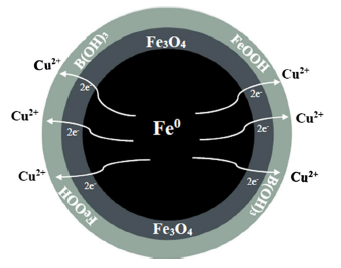
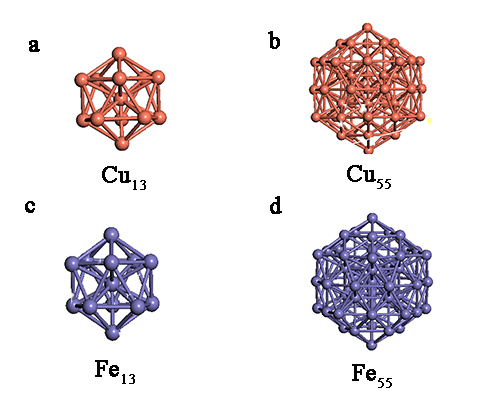
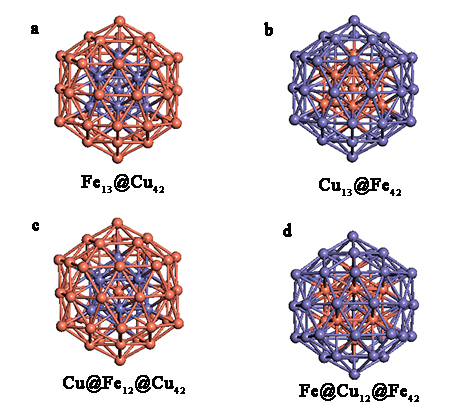

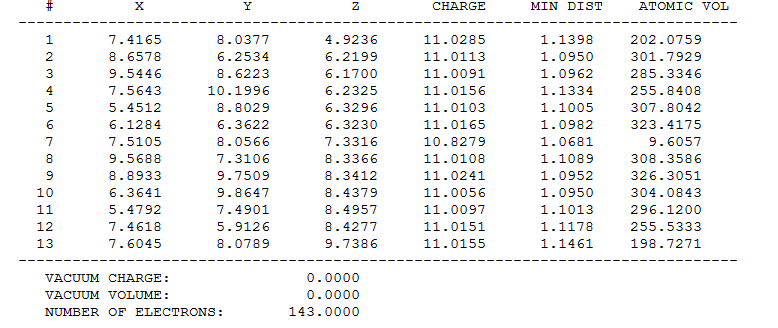
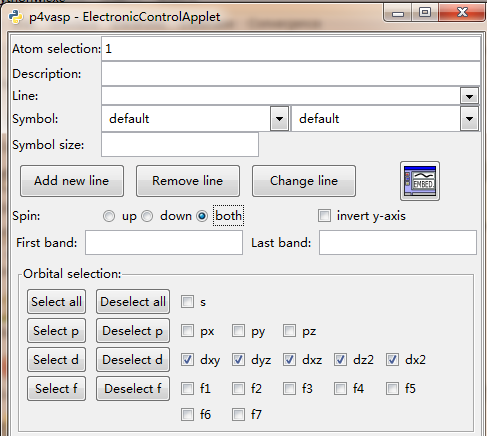
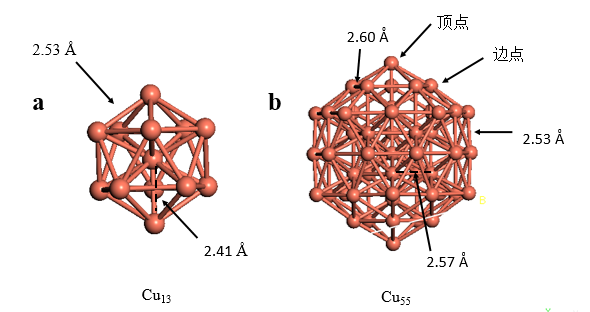
您可能感兴趣的文章
- BN嵌入型四苯并五苯:一种工具高稳定性的并五苯衍生物外文翻译资料
- MoS2和石墨烯作为助催化剂在增强的可见光光催化H2生产活性的多臂CdS纳米棒的作用外文翻译资料
- 通过在BiVO4的不同晶面上进行双助剂的合理组装制备高效率的光催化剂外文翻译资料
- 非编码RNA的固相合成研究外文翻译资料
- 氢化驱动的导电Na2Ti3O7纳米阵列作为钠离子电池阳极外文翻译资料
- 高能量及功率密度的可充电锌-二氧化锰电池外文翻译资料
- 利用导电聚合物纳米线阵列来增强电化学性能外文翻译资料
- 自支撑Na2Ti3O7纳米阵列/石墨烯泡沫和石墨烯泡沫准固态钠离子电容器电极外文翻译资料
- 基于碳纳米管金纳米粒子辣根过氧化物酶构建的过氧化氢生物传感器毕业论文
- 新型联二吡啶Pt(II)炔配合物的设计、合成及光物理性质研究毕业论文




